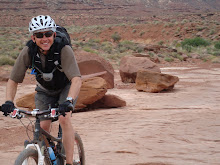I work on the 9th floor of a high-rise office building. A couple of months a go one of my co-workers mentioned that he had been taking the stairs up to our office every day. I was thrilled to learn his secret – you see, our building (as many high-rises do) has several locked stairwells. You might be able to go up or down a few flights, but your access back into the core of the building is restricted.
So, I found the secret “all access” stairway, and since then I have made an effort to take the stairs every day. Actually, I even put a reminder on my Outlook calendar that prompts me to do a set of stairs at two other times throughout the day, just to get me away from my computer and phone for a few minutes a day. [Have you ever noticed that the only people who actually get regular breaks at any job are the smokers? So I consider this my “smoke break for a non-smoker.”]
I don’t run the stairs – I just walk them at a comfortable pace and really try to focus on good form. I place my whole foot on the stair, not just my toes – that way my Achilles tendon gets a nice stretch.
Making small changes like taking the stairs, when it is reasonable, can add up over time. Walking up stairs at a moderate intensity should burn 5 calories a minute for a 120-pound person, 7 for a 150-pound person, and 9 for a 180-pound person. Running stairs multiplies the caloric burn and the cardiovascular benefit.
The impact on knees and feet is relatively low, with the pressure equivalent to two times one’s body weight walking up stairs (compared with three to four times when running. The pounding on the body going downstairs, however, equals six or seven times one’s body weight.
That is actually good news for me. The LA Times recently ran an article about a topic I had heard about some time ago - cyclists are at risk for bone loss. Cycling’s low-impact nature isn't conducive to building strong bones. So adding high-impact exercises can ease the risks of injury.
Although cyclists are known for staying on top of their training heart rate zones and pedal cadence, increasing research suggests they should also pay attention to their risk of thinning bones.
Many factors contribute to osteopenia (lower-than-normal bone density) or osteoporosis (very low bone mineral density) in cyclists, but one of the culprits is the nature of the exercise itself.
Cycling is a low-impact sport that puts little mechanical load on the bones. That's great if you have joint problems, but it's the weight-bearing nature of exercise that signals bones to create more mass. Without such stress, bones don't get stronger, making them more prone to injury.
Avid cyclists, both amateur and professional, seem to be especially at risk of bone injuries if they don't do any type of cross-training. The lower spine is a particularly susceptible area, since it gets almost no loading.
A recent study in the journal Medicine & Science in Sports & Exercise found that competitive male road cyclists had significantly lower bone mineral density in their spines than a control group of men who were moderately physically active while doing other recreational activities. They were also more likely to have osteopenia and osteoporosis than those in the control group, despite the fact that the cyclists had a greater calcium intake.
Further, some hard-core cyclists may not be eating enough to offset what they burn when exercising, depriving their bodies of bone-strengthening nutrients such as calcium and vitamin D.
Even perspiration can be a factor: Cyclists may lose a lot of calcium in their sweat. Even if they're taking in amounts [of liquid] that are seemingly high for the average person, that might not be enough to balance what they're excreting.
Bone loss can't be reversed overnight. Depending on the severity of the loss, it may take months or even years to see an improvement in bone mineral density.
In the meantime, take the stairs. It is a relatively easy way to work in a weight-bearing exercise to help in the battle to keep your bones strong and healthy.
Wednesday, February 25, 2009
Subscribe to:
Post Comments (Atom)


No comments:
Post a Comment